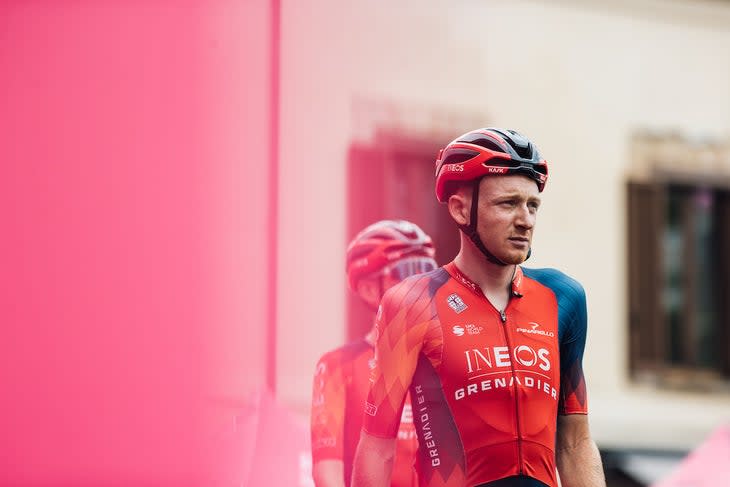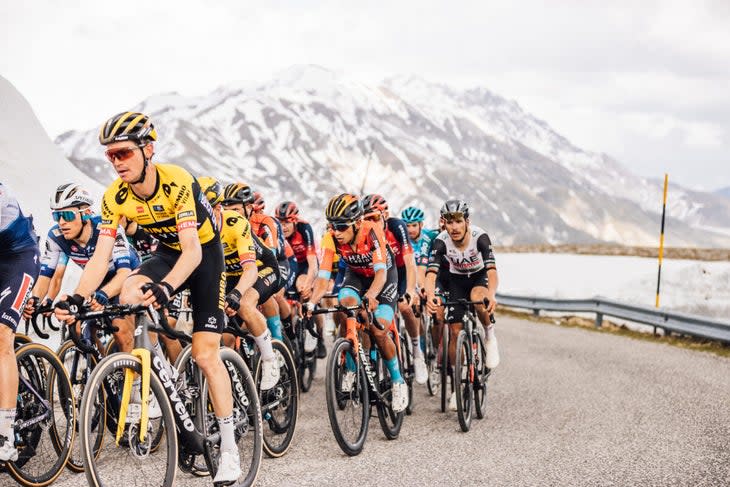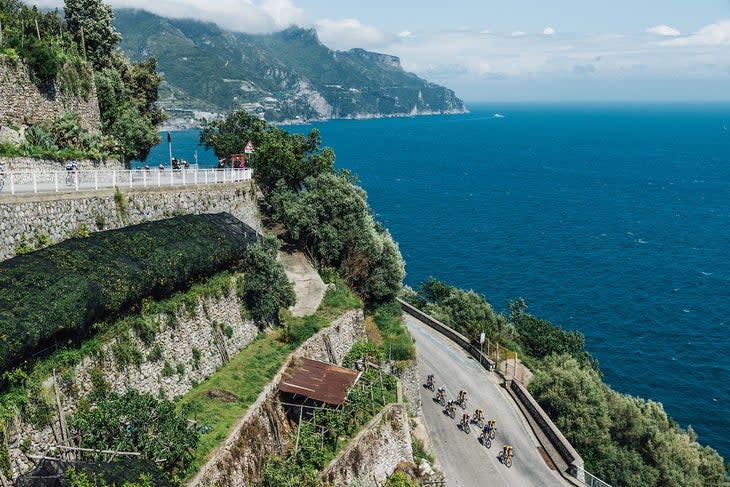Commentary: The Giro d’Italia is on a slow boil, but things will heat up fast
This article originally appeared on Velo News
The 2023 Giro d’Italia is on a slow boil, too slow for some.
After a week of racing, the biggest drama so far in the season’s first grand tour has come from freakish finish-line crashes (cue Mark Cavendish) or a stray dog taking down Remco Evenepoel.
Friday’s first major summit finale was a flop. Three riders who’ve never won a pro race between them rode away from a pack in full-on siesta mode and held on for the win. A strong headwind up the exposed climb with moderate ramps didn’t help, but everyone agreed it was a real snoozer.
What’s up?
Grand tour racing, that’s what.
As much as everyone would like to see fireworks, attacks, fearless sorties, and race-altering dynamics day in and day out, that just isn’t how a grand tour is raced.
Also read:
Fans are spoiled these days with start-to-finish live broadcasts of most grand tour stages. If they’re expecting Mathieu van der Poel-like throw-downs with 80km to go every day, they’re in for a rude surprise.
Yet in any grand tour, the good stuff almost always comes at the end.
Unlike the all-or-nothing dynamics of classics racing, grand tours are built on survival. It’s all but humanly impossible to attack on every mountain for three weeks straight.
A grand tour, and especially the Giro, is akin to the slow food of bike racing.
Saving the matches for when it’s time to burn

Stage racing is about picking the moment.
And so far in this Giro, that moment has yet to come.
Two key factors are shaping this Giro so far.
First are the front-loaded time trials. Saturday’s opener and this Sunday’s 35km pure power test all but hands the pink jersey to Evenepoel on a silver platter. Others are just trying to limit the damage and biding their time right now.
The second is the Giro’s trademark back-end brutal final week. Everyone knows how hard the closing string of cruel climbs, snowbound passes, and harrowing descents can be, and everyone is saving their matches to have a chance to light things up when it really counts.
The Giro organizers took a risk by packing the front half of the race with time trials. That typically producers larger gaps in the GC early on, meaning that some of the drama is automatically eliminated from the first week when sprinters will be chasing time bonuses for a shot at pink.
🔥 Third victory at the Giro for Michael Matthews after Montecassino 2014 and Sestri Levante 2015 🔥#Giro #GirodItalia @blingmatthews pic.twitter.com/hA41GSXMyw
-- Giro d’Italia (@giroditalia) May 8, 2023
Time trials also create an immediate hierarchy very quickly among the podium contenders, and hoovers out much of the nerves and tension out of the first week. Riders who are all but tied on time are much more attentive and race more aggressively if they’re knotted up on GC rather than having already bled out two minutes on the first stage.
Of course, those time trial kilometers attracted the likes of Remco Evenepoel, Joao Almeida, Aleksandr Vlasov, Geraint Thomas, and Primoz Roglic to the Giro this year in the first place.
Yet there is a real risk that Evenepoel could have minutes not just seconds on everyone coming out of this weekend.
There have been legitimate complaints about the peloton’s lack of commitment in some of the transition stages in the opening week of the race. A few days were veritable snooze-fests, which is par for the course at the Giro, but perhaps something new to fans watching it play out live for the first time.
Part of that blame can be placed on the race course designers. When the courses have been challenging and interesting, the racing has been superb, such as the gripping battle won by Michael Matthews in stage 3.
The Giro also likes to retain its old-school roots, and there were grumbles about the longish, 200km-plus stages populating some of the sprint and transition stages. Many wonder, and often times correctly, wouldn’t it deliver the same outcome if the stage was 175km instead of 210km?
Giro boss Mauro Vegni recoiled when asked about it on live TV, and replied, “What is this, junior racing?”
It’s always an interesting balancing act for grand tour race organizers. Yes, they too want something exciting every day. But it’s all but impossible to have it exciting all the time.
And if they make each stage too hard, riders will naturally hold back and ride even more conservatively until the final kilometers to make a move after enduring all the suffering that’s come before. Many of the peloton’s pure sprinters skipped this year’s Giro in part because many of the sprint stages are too hard.
And Vegni is right, though, in his contention that at the core grand tour racing inherently is about endurance, staying power, and suffering.
Alberto Contador back in his day pushed back against the modern trend started at the Vuelta a Espana more than 20 years of introducing very short mountain stages into the grand tour mix.
True, sometimes those 120km stages -- or even shorter -- can produce dynamic racing. The logic is that if the emphasis is on attacking rather than surviving, the end result is more pleasing and entertaining.
Yet those shorter stages often do not produce those race-breaking big splits in the GC. And with the peloton at a higher level across the board, organizers also trimmed down time trials so they wouldn’t suck the life out of the race.
It’s easier to take one minute or more in a 30km time trial than it is trying to claw back that time on an hors-categorie climb against evenly matched climbers.
The magic happens in the final week

The likes of Contador and other grand tour masters muttered, if everyone is fresh, no one’s ever going to crack.
And it is those spectacular cracks that make grand tour racing so beguiling.
With the level across the peloton so high, today’s top pros can only be stripped down to their most base human element well into the third week of a grand tour. A week-long stage race or something like the Tour de Suisse will never produce the pure drama and wild swings of fortune a grand tour can dish out.
And to get to that breaking point, the peloton needs to race these long, sometimes boring yards. It’s the accumulation of fatigue and stress -- both mental and physical -- that can bring anyone to the edge of oblivion and glory.
And that’s in part why there are no early Giro fireworks so far in this race. Every top pro can handle a week of WorldTour racing. It’s into the end of week two and into week three that the cracks start to appear.
Right now, everyone is looking at the final week with real trepidation, and they’re hoping and praying it’s not them whose legs turn to dust.
Riders are doing everything they can this week to conserve as much energy as possible with the outside hope that they will have still have something left in the tank in week 3 when it really counts.
Long transfers, poor weather, and growing concerns about a COVID-19 outbreak only pour more water on the embers right now.
It's 22:07 and Giro d'Italia stage 7 is still going
🚗 45 minutes to the start
🚴🏼♂️ 218km stage
🚗 Getting off the mountain
🚌 2-hour post-race transfer
🛠️ The work beginsWe would be nowhere without our staff!
--
🇮🇹 #Giro pic.twitter.com/2bir850Wfb-- Israel - Premier Tech (@IsraelPremTech) May 12, 2023
And with Evenepoel looking untouchable right now, rivals are wisely waiting for a more opportune scenario. Friday was not that moment.
Of course, the Giro like any race can produce surprises at any point of the race. Saturday’s rollercoaster might serve up a trap for some riders. Every bend or finishing straight can hold an unwelcome surprise. Who could have imagined world champion Evenepoel would be taken down by a stray dog?
But the truly decisive moments are always packed into week 3. That’s when the magic happens in the Giro.
Chris Froome’s famous raid in 2018 is the perfect example of the hallmark race-changing swing of fortunes. Froome risked it all with a then-unheard of solo attack with 80km to go.
The team was on the vanguard of how riders are fueled and hydrated during a long stage, and though many howled that Froome must have had a motor in his bike, Froome simply broke the back and spirit of then-leader Simon Yates, who lost 20 minutes and plummeted down the results sheet when he couldn’t answer.
Of all the grand tours, it’s the Giro that consistently produces these wildly entertaining final-week collapses and heroic reversals.
Vincenzo Nibali snatched back the Giro in 2016 by putting leader Steven Kruiswijk against the ropes and into a snowbank high in the Alps. Even last year’s Giro came down to one searing attack from Jai Hindley and an ever so slight crack from Richard Carapaz on the Marmolada.
Don’t worry, the best is yet to come in this Giro.
The good stuff always happens at the end in the corsa rosa. Add monster climbs, crazy weather, insane descents, and the tifosi throngs, and the Giro is unique in modern cycling.
This Giro might be on a slow simmer right now. Slow food always tastes better. You just have to have the patience to wait for the main course to arrive.
And when it does, mamma mia, is it tasty.

For exclusive access to all of our fitness, gear, adventure, and travel stories, plus discounts on trips, events, and gear, sign up for Outside+ today.

